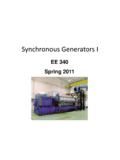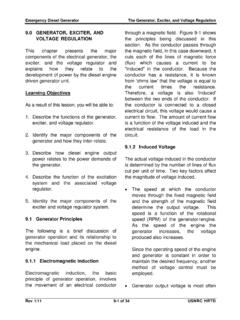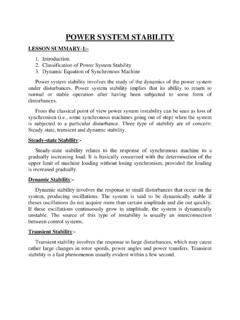Transcription of Permanent Magnet Synchronous Machine Model for Real
1 Permanent Magnet Synchronous Machine Model for Real- Time Simulation A. B. Dehkordi, Student Member, IEEE, A. M. Gole, Senior Member, IEEE, T. L. Maguire, Senior Member, IEEE Abstract--This paper presents the implementation of a Model for a Permanent Magnet motor on a real time digital simulator. The conventional interfaced Model approach popular in some emt-type programs is shown to be inappropriate for real-time simulators, because it is more susceptible to numerical instability. The paper introduces an embedded phase domain Model which reduces numerical instabilities. Both the conventional as well as the embedded phase domain Model models are shown to provide identical results in the steady state and transient situations; however the conventional Model becomes unstable quickly if the time-step is increased.
2 This paper also presents the application of this new Model to simulate the Machine using the evaluated inductances that have been evaluated by (FEM) method based modeling. Keywords: Permanent Magnet machines, real time digital simulator, Electromagnetic transient analysis, embedded Model of the Machine , numerical instability. I. INTRODUCTION N recent years, Permanent Magnet Synchronous Motors (PMSMs) are increasing applied in several areas such as traction, automobiles, robotics and aerospace technology [1]. Accurate digital simulation tools are necessary to evaluate their field performance particularly when they are driven with solid-state drives connected to larger electrical networks. One of the areas of interest is the design of controllers for these motor drives.
3 In many applications the physical controls have to be designed and tuned for best performance. If the simulation of the motor and drive can be implemented in real-time, it becomes possible to interface the physical manufacturer-built controller (not its Model ) and protection equipment to the simulation using appropriate digital-analog and analog-digital converters. The real time digital simulator is a combination of specialized computer hardware and software designed specifically for the solution of power system electromagnetically transients in real-time. One such real-time digital simulator is the RTDS . Since the RTDS This work has been done with the financial support of RTDS Technologies Inc. A.
4 B. Dehkordi is with the University of Manitoba, Winnipeg, Canada (e-mail: A. M. Gole is with the University of Manitoba, Winnipeg, Canada (e-mail: T. L. Maguire is with RTDS Technologies Inc., Winnipeg, Canada (e-mail: Presented at the International Conference on Power Systems Transients (IPST 05) in Montreal, Canada on June 19-23, 2005 Paper No. IPST05 - 159 combines the real time operation properties of analogue simulators with the flexibility and accuracy of digital simulation programs, there are many areas where this technology has been successfully applied [2]. Traditionally transient simulation programs use the dq0 based modeling method to Model different types of machines and the machines are interfaced to the network.)))
5 These interfaced models have interfacing delays which can cause numerical stability problems in the presence of other interfaced components, particularly when the case is running in real time. Modeling the Permanent Magnet machines in RTDS has important industrial applications such as maglev trains and new generation of automobiles. This paper presents two different approaches to Model the Permanent Magnet Synchronous Machine in RTDS, the traditional dq0 Model of the Machine and the embedded phase domain Model . According to second method the Machine is modeled as a set of time-variant mutual inductances. The machines are compared in the transient and steady state situations, and in the final step their performance is observed with an inverter, supplying the AC voltage for the terminals of the Permanent Magnet Synchronous machines.
6 II. EQUIVALENT CIRCUIT Model OF THE PMSM A. Structure of the Permanent Magnet Machine The cross-sectional layout of a surface mounted Permanent Magnet motor is shown in STATORMAGNETROTORCORE Fig. 1. Structure of the Permanent Magnet Synchronous Machine [3] The stator carries a three-phase winding, which produces a near sinusoidal distribution of magneto motive force based on the value of the stator current. The magnets are mounted on the surface of the motor core. They have the same role as the I field winding in a Synchronous Machine except their magnetic field is constant and there is no control on it [3]. B. Equivalent dq0 Model of the PM Machine The dq0 equivalent circuit of the PM Machine shown in is similar to the one for the Synchronous Machine ; it has the armature resistancesR, d and q axis leakage and mutual inductancessl, mdLandmqL.
7 0d mqLqddt + + qVqislsR0q mdLdddt + + dVdimRmififddt + sRsla)b) Fig. 2. Dq0 Equivalent circuit Model of the PMSM a) D axis b) Q axis The rotor Magnet can be considered as a loop of constant current source, mi located at the stator direct axis. Any change in the magnetic flux of the rotor Magnet will cause an induced electromagnetic force, resulting in a circulating current in the Magnet [3].Essentially resistance mR connected across the direct-axis magnetization inductance mdL shows this effect [3]. There is no leakage inductance in the field . The permeability of the Magnet material is almost unity so the air gap inductance seen by the stator is the same in direct and quadrature axes and also no saturation will happen inside the Machine . Fig.
8 3 shows the demagnetization curve of the Magnet that can be divided into three regions by three lines, called no-load, rated-load and excessive-load lines [4]. Fig. 3. Demagnetization curve of the Permanent Magnet [4] We always try to not enter the excessive load region; otherwise the Magnet is in danger of being damaged. The equations for the dq0 Model of the Permanent Magnet Synchronous Machine are: ddsdqfmmm fqqsqddVRidtdRiRidtdVRidt = = = + (1) 0000dsmmdfmmfqsmqLLLiLLiLLi + = + (2) The Magnet is modeled by a current source mi parallel to the resistancemR. This part of the circuit can be modeled as a thevenin equivalent circuit, so that the direct axis equivalent circuit of the Machine will be the circuit shown in Fig.
9 4. mmRimR0q mdLdddt + + dVdififddt + sRsl Fig. 4. D axis thevenin equivalent circuit of the PMSM This Model is similar to the conventional equivalent circuit of the Synchronous Machine , except there is no leakage inductance on the field . C. Typical data for the PM motor The data used for the simulations in this paper is from a 3-phase 208-volt, 6 kW test motor used by the Sebastian and Slemon [3]. Table 1 shows the value of the Machine parameters. The base values of the voltage and current are RMS values of the stator phase voltage and current. III. INTERFACE Model OF THE PMSM IN RTDS Equations (1) and (2) can be used in the diagram of to interface the Machine to the network. In every time step the program reads the voltage from the previous time step and applies the Park transform to get the dq0 components of the voltage, then using (1) it calculates the derivatives of the fluxes.
10 Predictor corrector integration calculates the new values of the fluxes and by multiplying the inverse of inductance matrix to the fluxes, dq0 component of the currents can be obtained. Using the inverse Park transform we have the phase currentsai, bi and cithat can be injected to the network. (from previous time step)Eq (1)diqifiEq (2)(for injection)ParkTransformInverseParkTransf orm,,abcvvv0,,dqvvv,,dq f ,,dq f ,,abciii Fig. 5. Interfacing the Machine to the network. IV. EMBEDDED Model OF THE PMSM IN RTDS The Machine can be modeled as set of mutual inductances that change in value with time. In this case the Model doesn t have the problem of interface that may cause numerical instabilities. This Model doesn t use the Park transform and directly solves the Machine equations in phase domain.

















